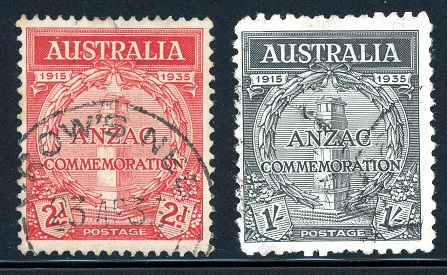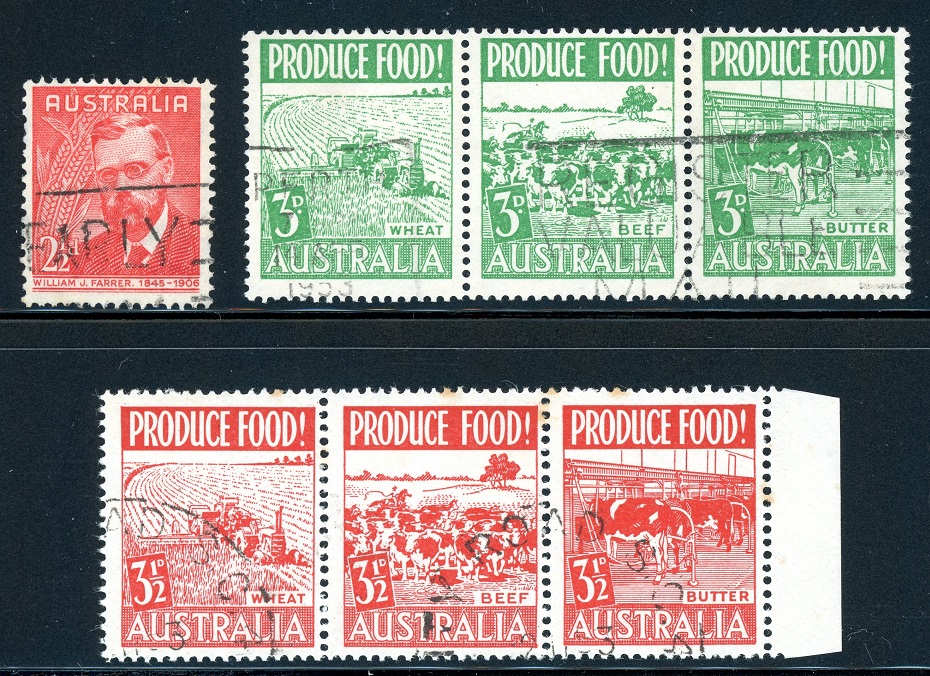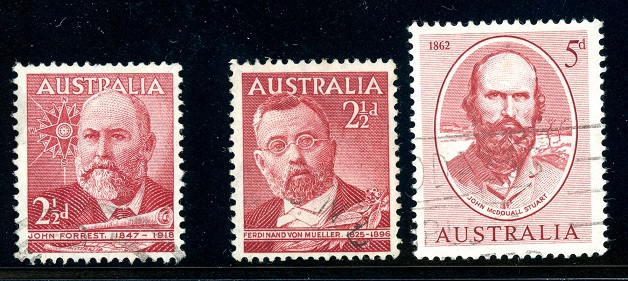Australian history in a nutshell - 2
Australian Forces played a key role in WW1. Most remembered in Australia seems to be to the 1915 Gallipoli campaign, for which commemorative stamps were issued in 1935.

General Sir John Monash, the commander of Australia's forces, was a superior strategist instrumental to Allied successes on the Western Front. One of the last pre-decimal stamps to be issued commemorated his 100th year of birth. The transmission towers in the background refer to his role as Chairman of the State Electricity Commission of Victoria.

After the end of WW2, stamp issuance resumes with the commemoration of the 100th Anniversary of exploration of Central Queensland by Thomas Mitchell. At the time, Queensland was the youngest state as the Northern Territories were not formed until 1978. The settlement of Tasmania in 1803-4 was remembered with a stamp issue in 1953.

In 1797 John Shortland discovered coal deposits near what is now Newcastle Port at the estuary of the Hunter River. Heavy industry flourished around the coal deposit, and Newcastle became and remains the largest coal handling port in the world. This 1947 series of stamps features John Shortland, the Broken Hill Proprietory Steel Foundry (1914) and the port itself. After decades of declining competitiveness relative to mainly Asian competitors, the Foundry was closed down in 2019, just as the wisdom of the pursuit of the lowest cost above all else began to be questioned. This series broke from the mould in that it comprised of different designs and shapes for the 3 values. The small size 2-1/2p commemorative in this series sets the pattern for a number of similar issues over next years. Last of those is the 1951 issue commemorating Edward Hargraves the prospector credited with Australia's first gold discovery at Ophir, NSW in 1851.

Before coal became the leading export for three decades starting in the 1980s, this crown was briefly held by wheat. William J. Farrer developed a strain of wheat resistant to the black stem rust disease that had caused a major decline in harvests in 2H 19th C. This 'Federation Wheat' was also drought resistant. In 1953, in response to an FAO alarm that global food production was lagging population growth, Australia embarked on a campaign to 'Produce Food'. Over the next two decades wheat acreage tripled from 4.08m ha in 1952. Over the past decades, the planted area has fluctuated around the 12-14m ha level, but a more than doubling of yield means that output has continued to grow. In the year ended Jun-22 Australia had a record wheat production of 36m tons.

The William Farrer commemorative stamp was followed by an issue for Sir Ferdinand von Mueller, a German immigrant botanist who identified and named many Australian plants as part of various expeditions through the Australian interior. One of his collaborations was the Western Australian surveyor Sir John Forrest who made the inland crossing to Adelaide in 1874. He later became Premier and Treasurer of the Colony of Western Australia, and after Federation twice served as Treasurer in the Deakin Government. The final critical inland exploration opening the road from South to North Australia was made in 1862 by Sturt protegeJohn McDouall Stuart, and commemorated with a stamp issue 1962.

The Australian Commonwealth turned 50 in 1951. Stamps show the two people most instrumental in bringing the federation about, as well as the opening of the first Federal Parliament session in Melbourne, and the Parliament House in Canberra that was completed only in 1927 and also the subject of Australia's first commemorative stamp issue.
By now Australian society had come of age, and Australia was internationally regarded becoming, after the US, the second non-European country to host the Olympic Games in 1956 (stamps shown in the next section. ).
But the story of the discovery and unification of Australia had not yet been fully told. 1954 saw the centenaries of the introduction of the telegraph the railways, with the first introduction of mail coaches being featured the following year.

In 1963 the 150th anniversary of the exploration of the Blue Mountains, provided the occasion for a stamp issue for this first significan inland expedition that opened the road from Sydney to the hinterland.
In the same year, the final High Value issue of the pre-decimal era featured the European explorers who 'discovered' and mapped Australia, capping coverage of the seminal events of Australia's early history of European settlement.
Other stamp issues of the 1950s and 60s, other than remembering Australia's contribution to WW2, show aspects of society and culture. Some of these are shown in the following section.